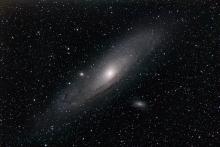Listen to today's episode of StarDate on the web the same day it airs in high-quality streaming audio without any extra ads or announcements. Choose a $8 one-month pass, or listen every day for a year for just $30.
You are here
Galactic Remnant
The most-distant object that’s readily visible to the eye alone stands directly overhead at nightfall now, in the constellation Andromeda. Under dark skies, M31 looks like a tiny cloud. But it’s really a giant spiral galaxy much like our own — about two and a half million light-years away.
It’s the closest of all big galaxies, so it’s a popular target for astronomers. And one team recently found what may be a mid-sized black hole in its outskirts.
The black hole is in a star cluster that’s about six million times the mass of the Sun. It’s been classified as a globular cluster — a tightly packed ball of stars as old as the galaxy itself.
The new study used telescopes on the ground and in space. Their observations showed that the cluster’s light tapers off in an odd way. The stars at its center appear to be orbiting something that’s small but massive. And the cluster isn’t as old as the galaxy. From that, the astronomers concluded that a rare mid-sized black hole inhabits the cluster’s heart. It’s about a hundred thousand times the mass of the Sun.
The cluster probably began as the core of a smaller galaxy. As the galaxy passed near M31, its outer precincts were pulled away by M31’s more powerful gravity. The stars in those regions merged with M31. The core stuck together and entered orbit around the larger galaxy. And that’s where it is today — the remnant of a dead galaxy with a black hole in its heart.
Script by Damond Benningfield





